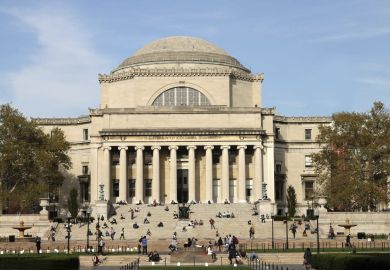The entrance to a university often hints at the kind of education it offers. In his memoir, Imagined Life, Richard Hoggart described how “goodwill breathed from the bricks” of the bustling main lobby of Goldsmiths, University of London. It was, he said, a place where “intense vitality [was] felt the moment you crossed the threshold in the crowd, saw the tattered linoleum, smelled cheap but largely unattractive food and heard the gabble”.
I am not sure what he would make of what is now known as the Richard Hoggart Building. The linoleum has been replaced by tiled floors, the canteen odour of boiled vegetables by the aroma of Costa coffee. The entrance is decorated by university branding and plasma screens. But at least it has remained an open campus, with no security checks (at least at its main entrance).
That is now unique among London campuses, as concern about security becomes ever more acute. It feels like it would be easier to break into a bank than gain access to some of the capital’s institutions. But lanyards and security passes designate university estates as places of work, rather than places of social gathering. They separate students – who are, in effect, paying for entry – from untenured citizens denied the privileges of university admission. This filtering by race and class remains, of course, unspoken.
It is hard enough for academic visitors to gain access to some universities. On Twitter, I recently commented on my troubles getting past security at one of the UK’s more prestigious institutions – despite having been invited there. “Too right,” replied one colleague. “Even my postgrads aren’t allowed a swipe card to get to my office.” She blamed the lack of a reception desk in the vicinity: “They have to phone me and get me to collect them. That’s the real Russell Group ‘experience’.”
I don’t want to minimise the importance of safety on campus for students or staff. There have been instances, albeit rarely, when the everyday social damage and violence of divided cities has arrived on campus. In the US, these are most evident in the shooting sprees blighting college campuses with depressing regularity. But some institutions seem far more committed to their role as meeting places, while others are happier to become gated communities.
It is often the security guards and receptionists who have the difficult work of managing the tensions of a space that is both public and private. These uncelebrated colleagues become the public faces of universities, and they don’t always get it right.
The urge to shut out people who are not students or staff is surely linked to the commercialisation of UK higher education – which has, in turn, financed multimillion-pound projects to renovate campuses. But the results can change how we feel about places of work and learning. One academic told me that she often finds herself reaching for her bank debit card to swipe into her department – a slip highlighting the “pay as you go” nature of contemporary universities.
It isn’t all one-way traffic, though. In 2012, the University of Worcester opened the country’s first joint university and public library, while expensive new campuses for the University of Northampton and Ulster University have been deliberately built closer to the city centre to attract more non-students.
That approach has also been successful in continental Europe, where libraries, lecture halls and seminar rooms are open to the public as much as coffee shops are. And one Canadian academic I know recalls that in her days as a student at Simon Fraser University in British Columbia, it was rumoured that homeless people would sit in on lectures to keep warm.
I really got a sense of that kind of public ethos during a recent teaching stint at Brazil’s Federal University of São Carlos: a public university, where higher education is mostly free. University branding was minimal, and teaching was reminiscent of the inspiring chaos that characterised British lecturing before tuition fees, the National Student Survey and university league tables.
This eccentric homeliness is encapsulated in the tale of Podrão (literally, “dirty” or “ripe-smelling”), the university’s much-missed scholarly dog. Podrão had an uncanny capacity to find where lectures in sociology and philosophy were being taught on campus, and would attend them regularly. Opening the door with his unkempt snout, he would sneak into the back, much to the delight of the students. Indeed, he acted so much like one of them that a legend started to circulate that he was a human in dog form. Graffiti appeared on the campus attesting to the fact.
Modern British campuses have become somewhat notorious in certain circles for offering sessions for students to alleviate exam stress by cuddling and petting “therapy dogs”, but dogs are definitely not permitted to roam freely on campus. Yet unexpected encounters – canine or otherwise – are not always unpleasant, and minimising their possibility makes us all poorer.
As our new students enjoy their first days at university, it is a good moment for us to ask what the physical environment of our respective campuses communicates to them – and to the people whose communities they have moved into. Are they buildings that breathe goodwill? Or do they advertise a different message about the nature of modern universities?
Restricting campus access may spare the linoleum, but it also risks blocking out some of the perspectives that higher education is supposed to open up.
Les Back is professor of sociology at Goldsmiths, University of London.
POSTSCRIPT:
Print headline: Keep it free range
Register to continue
Why register?
- Registration is free and only takes a moment
- Once registered, you can read 3 articles a month
- Sign up for our newsletter
Subscribe
Or subscribe for unlimited access to:
- Unlimited access to news, views, insights & reviews
- Digital editions
- Digital access to THE’s university and college rankings analysis
Already registered or a current subscriber? Login








